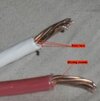golferguy
Member
That is my thought too. Wire connections did not show excessive heat but buss bar connection did. I think it is odd that Electric Panels are outdoors but if that is the local code, so be it.It looks like the breaker melted at the bus bar connection, so I'm wondering whether the exposed bus bar there had become weathered/corroded/dirty over the years. I'm surprised that the 60-amp breaker didn't trip thermally if it was radiating enough heat to trip the GFCI breaker next to it!
Glad you caught it!
I have a whole home generator. When the transfer switch was installed I demanded it go in the garage, not outside which is allowed here. Electrician had a fit until I showed him the spec on the transfer switch housing. It is spec'd to 40 mph winds. The purpose of my generator is for Hurricanes. 40mph ha!
It is inside the garage and after 10 years looks like new.



